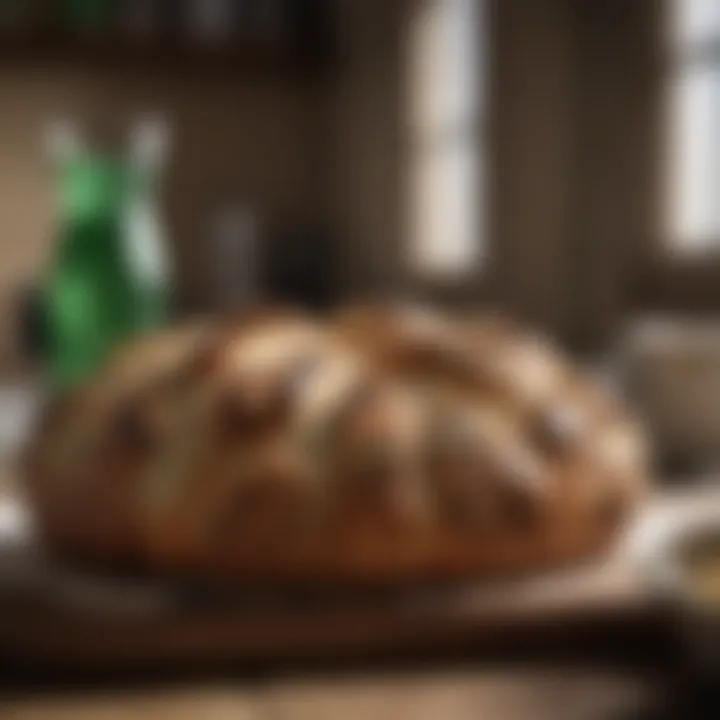Exploring St. Patrick's Day Dinner Traditions


Intro
St. Patrick's Day dinner is a unique affair that intertwines culinary practices with cultural heritage. It is a time for families and friends to come together to honor the legacy of Ireland and its rich traditions. Rather than merely serving a meal, these dinners embody a spectrum of historical narratives and social connections that enrich the experience.
The holiday itself is rooted in spirituality and nationalism, celebrated on March 17th to honor St. Patrick, the patron saint of Ireland. Over the years, St. Patrick's Day has transformed into a global celebration, extending beyond the Emerald Isle. This evolution has led to various adaptations in how the dinner is prepared and enjoyed, making it more relevant to contemporary lifestyles.
This exploration will cover several key points. First, it will delve into the historical significance of traditional dishes associated with St. Patrick's Day, such as corned beef and cabbage, colcannon, and soda bread. Next, the article will examine the role of family and community during these dinners, reflecting on how these gatherings strengthen social bonds. After that, we will consider modern interpretations of traditional foods, catering to diverse dietary preferences that have emerged in recent years.
Additionally, practical tips for organizing a memorable St. Patrick's Day dinner will be discussed, focusing on ways to blend authentic practices with current culinary trends. Each section aims to provide the reader with insightful advice, ensuring a celebration that resonates on both personal and communal levels. As we unfold this narrative, the emphasis will be on understanding the traditions, appreciating their significance, and celebrating them with a modern twist.
Historical Significance of St. Patrick's Day
St. Patrick's Day carries profound historical significance that extends far beyond its modern-day celebratory aspects. This section highlights how the day has evolved over centuries and how its origins influence current traditions. Recognizing the historical context allows individuals to appreciate the cultural richness embedded in St. Patrick’s Day dinners. It showcases the journey through time, shedding light on the reasons behind enduring culinary practices and family gatherings.
Origins of St. Patrick's Day
The origins of St. Patrick's Day date back to the early 17th century when it was established as a feast day honoring St. Patrick, the patron saint of Ireland. According to historical accounts, St. Patrick was instrumental in converting the Irish to Christianity during the 5th century. His influence was profound, as he is credited with introducing key Christian concepts to the Irish people. The day became an occasion for religious observance and cultural reflection, especially for Irish communities.
As time passed, St. Patrick's Day transformed into a broader celebration of Irish identity and heritage. This shift is particularly evident in the 18th and 19th centuries when Irish immigrants in America began hosting parades and festivals, showcasing their culture in countries that sometimes marginalized them. When you sit down for a meal on St. Patrick’s Day, you participate in this long-standing tradition, where each dish carries the weight of history and cultural pride.
Culinary Practices Through the Ages
Culinary practices on St. Patrick's Day reflect a rich tapestry of traditions that have developed over the centuries. In ancient Ireland, meals were simple and relied heavily on locally sourced ingredients such as potatoes, cabbage, and meats. The introduction of the potato in the 16th century significantly changed the diet of the Irish people, leading to staple dishes that would later define the holiday’s culinary scene.
With the influx of Irish immigrants to America, these traditional dishes evolved, influenced by the availability of new ingredients and local tastes. Corned beef and cabbage became widely recognized as a St. Patrick's Day dish, despite its different origins. This dish highlights the adaptive nature of Irish cuisine, which has always relied on the ingredient availability and cultural exchanges.
In summary, the culinary tradition of St. Patrick's Day presents a unique journey from ancient practices to modern interpretations, reinforcing the ongoing impact of history on current dining experiences. Understanding these origins helps in crafting a dinner that honors both tradition and innovation.
Traditional Irish Dishes for St. Patrick's Day
Understanding the significance of traditional Irish dishes during St. Patrick's Day involves more than just recognizing their culinary appeal. These dishes serve as a bridge connecting people to their heritage and history, embodying cultural values and communal bonds. The celebration itself is intertwined with food, as it fosters family gatherings and offers an opportunity to reflect on one's ancestry. Traditional meals are often crafted from locally sourced ingredients, making them significant not only to the palates of the celebrants but also to the economy of local farmers and suppliers.
In this section, we focus on three iconic dishes central to the St. Patrick's Day dinner: Corned Beef and Cabbage, Irish Soda Bread, and two variations of potato dishes, Colcannon and Champ. Each dish carries its own story and method of preparation, along with flavors that have evolved through generations. As society changes, the way these dishes are interpreted also shifts, highlighting the adaptability of tradition while preserving its core essence.
Corned Beef and Cabbage
Corned beef and cabbage is one of the most recognized dishes on St. Patrick's Day, particularly within American celebrations. Though not originally an Irish staple, it became prominent among Irish immigrants in America during the 19th century. The dish symbolizes comfort, nourishment, and affordability, using simple ingredients that are widely accessible.
Preparation of corned beef involves curing a cut of beef in a brine solution. This process infuses the meat with flavors while ensuring its preservation. When served alongside cabbage, the flavors meld together harmoniously. This dish serves as a reminder of how food can evolve over time, shaped by cultural integration while still paying homage to its roots. Celebrating with corned beef also encourages discussions about the immigrant experience, making it a meaningful part of the dinner.
Irish Soda Bread
Irish soda bread is not just a delicious accompaniment to any meal but also an integral part of Irish culinary history. Dating back to the 19th century, this bread became popular due to the availability of baking soda as a leavening agent. Unlike traditional yeast breads, soda bread uses baking soda to rise, making it quick and easy to prepare.
The ingredients are basic: flour, baking soda, salt, and buttermilk. The simplicity reflects the resourcefulness of Irish families who had to work with what was available. Often, variations of the bread include added ingredients like raisins or caraway seeds, enhancing its flavors. The communal act of baking Irish soda bread provides a foundation for family traditions, highlighting the togetherness that food fosters.
Colcannon and Champ
Colcannon and Champ are two comforting Irish potato dishes that are staples during St. Patrick's Day celebrations. Colcannon typically consists of mashed potatoes mixed with cabbage or kale, while Champ features mashed potatoes blended with scallions. Both dishes reflect the humble origins of Irish cooking, showcasing potatoes, a crop that has had a lasting impact on the country.
The preparation of Colcannon often includes a bit of butter and cream, enhancing its richness. This dish symbolizes the heartiness of Irish cuisine. On the other hand, Champ brings a fresh flavor with the incorporation of scallions, illustrating how easy ingredients can create several delightful variations. These dishes not only highlight Ireland's agrarian culture but also invite families to gather and enjoy a meal together, preserving the legacy of Irish cooking.
In summary, the traditional Irish dishes associated with St. Patrick's Day are much more than meals. They encapsulate history, foster connections among families, and reflect the adaptability of cultural practices. Embracing these dishes not only reaffirms one's identity but also contributes to the ongoing celebration of Irish heritage.
Modern Interpretations of St. Patrick's Day Dinner
The observation of St. Patrick's Day dinner has evolved significantly over the years, reflecting broader cultural shifts and culinary trends. It is no longer confined solely to traditional Irish fare. Modern interpretations incorporate diverse influences and dietary preferences, making them more inclusive for a wider audience. This evolution highlights the importance of adaptability in culinary practices, allowing families to craft unique experiences that resonate with their values and backgrounds.
The shift towards modern interpretations emphasizes creativity while respecting the historical and cultural aspects of this celebration. The fusion of cuisines and dietary trends facilitates an engaging dining experience. Guests can explore flavors and techniques that might not be present in traditional recipes, all while maintaining a connection to the essence of St. Patrick's Day.
Fusion Cuisine Approaches


Fusion cuisine represents a significant shift in how St. Patrick's Day is celebrated. This approach blends traditional Irish elements with culinary styles from around the world. For instance, one might see corned beef tacos, which combine quintessential Irish meat with Mexican flavors and presentations. Another example can be found in Irish-Italian dishes like shepherd's pie lasagna. The combinations seem endless as cultures intermingle in contemporary kitchens.
These creative dishes not only attract attention but also reflect global cultural interactions. Families can engage in discussions about different heritages while enjoying a meal that represents their unique backgrounds. The fusion approach allows for endless possibilities, catering to diverse preferences and dietary needs.
Benefits of Fusion Cuisine:
- Encourages culinary exploration.
- Provides options for various dietary restrictions.
- Celebrates multiple cultures in a single meal.
The Vegetarian and Vegan Shift
The growing shift toward vegetarian and vegan diets has also influenced the way St. Patrick's Day dinner is conceptualized. Traditional meat-heavy dishes are being reimagined to cater to plant-based diets. Dishes like colcannon have found new life through the use of mashed cauliflower instead of potatoes or incorporating lentils into traditional Irish stew as a protein base.
This shift also raises awareness about sustainability and health-conscious eating, appealing to individuals who prioritize these values. The emphasis on vegetables, legumes, and whole grains fosters a greater appreciation for diverse ingredients, showcasing the richness of plant-based cooking.
Considerations for Vegetarian and Vegan Dinners:
- Highlight local produce and seasonal ingredients.
- Offer savory plant-based alternatives to traditional meats.
- Include creative seasonings to enhance flavors and textures.
Embracing modern interpretations of St. Patrick's Day dinner allows each generation to contribute their tastes and preferences to a festival that carries profound historical meaning.
The Impact of Family and Community
The significance of family and community in celebrating St. Patrick's Day cannot be overstated. These aspects form the foundation of the festivities. St. Patrick's Day serves as an opportunity for families to come together and strengthen their bonds. During dinner gatherings, shared rituals and culinary experiences foster a sense of belonging. This enrichment often enhances interpersonal relationships and uplifts community spirit. The act of preparing and enjoying a meal with loved ones not only sustains traditions but also creates memories that can be cherished for years.
Moreover, participating in communal celebrations elevates the experience of St. Patrick's Day. Beyond individual households, larger community events provide venues for sharing food and joy with broader groups. These gatherings often include parades, festivals, and local markets, creating an atmosphere that celebrates togetherness. This sense of unity breaths life into cultural practices, ensuring that they continue to thrive in modern society.
Family Traditions and Gatherings
Family traditions play a crucial role in how St. Patrick's Day is observed. Each household may have its unique customs that reflect their heritage or personal tastes. Some families gather on the eve of the holiday for a special meal, often rooted in recipes passed down through generations.
- Sometimes, these traditions involve storytelling, where older family members share tales of their ancestors' experiences in Ireland.
- They may also include the preparation of specific dishes, such as corned beef and cabbage, that hold special meaning.
- Engaging in these customs emphasizes the importance of family identity and history, reinforcing the connection to one’s roots.
In addition to food, games and activities can be part of these gatherings, further enriching the experience. Such interactions create a platform for sharing laughter, joy, and a collective sense of cultural pride.
Contribution of Culinary Heritage
Culinary heritage is a vital component of St. Patrick's Day celebrations. The recipes and cooking techniques associated with this day reflect the diverse history of the Irish people. Each dish tells a story about the past, conveying values, struggles, and successes.
For instance, Irish Soda Bread symbolizes the ingenuity of families facing scarcity, while meals like colcannon showcase the importance of agriculture and seasonal ingredients. Incorporating these traditional recipes into the dinner provides an authentic experience, linking participants to their ancestry.
Furthermore, sharing these dishes with the community enriches the cultural fabric of St. Patrick's Day. Food becomes a powerful medium for cultural exchange, allowing various ethnic groups to learn from each other. Therefore, the culinary contributions toward St. Patrick's Day serve not only to honor individual history but also to promote cultural diversity, creating a richer celebration for all.
"A family meal, particularly on a festive occasion like St. Patrick's Day, is more than just eating; it is an act of connection and remembrance."
Planning the Perfect St. Patrick's Day Dinner
Planning the perfect St. Patrick's Day dinner involves thoughtful consideration of various elements that make the celebration memorable. This occasion is marked not only by the food served, but also by the overall experience shared among family and friends. It provides an opportunity to honor traditions while accommodating modern tastes and dietary preferences. Therefore, creating a well-structured plan will ensure that the event flows smoothly, allowing everyone to enjoy the festivities without unnecessary stress.
One of the primary benefits of careful planning is the ability to cater to different tastes and dietary needs. With a diverse audience in mind, it's important to consider both traditional Irish dishes and contemporary options. Menu planning should focus on balancing flavors and nutritional elements. Additionally, ease of preparation plays a significant role; selecting recipes that can be made ahead of time can save valuable moments on the day of the event.
Furthermore, planning the table setting and décor adds an aesthetic touch to the celebration. A well-decorated dining area enhances the festive mood and creates an inviting atmosphere. This article will provide insights into how both food and décor contribute to a cohesive St. Patrick's Day experience.
Preparing a dinner that respects both historical practices and modern lifestyles can also foster discussions and connections among guests. Creating a space where diverse cuisines are welcomed encourages conversations about heritage and cultural diversity, enriching the overall experience for all.
Ultimately, planning is the foundation of a successful St. Patrick's Day dinner. With thoughtful menu selections and careful attention to décor, your gathering can reflect the spirit of the holiday in a way that is both engaging and fulfilling.
Menu Selection and Recipe Ideas
When selecting the menu for your St. Patrick's Day dinner, a key factor is representation. Aim to include a blend of classic Irish dishes and modern interpretations that appeal to everyone's preferences. Dishes like corned beef and cabbage should be staples, yet consider incorporating options like Irish stew or shepherd's pie to offer variety.
It's also wise to think about dietary restrictions. Including vegetarian or vegan options caters to those who may not eat meat. For instance, consider a hearty vegetable stew or a plant-based colcannon. Using seasonal vegetables ensures freshness and taste.


A few recipe ideas to consider include:
- Corned Beef and Cabbage: A must-have for traditionalists.
- Vegetarian Shepherd's Pie: A plant-based take on the classic.
- Irish Soda Bread: Simple to prepare and pairs well with many dishes.
- Colcannon: A comforting potato dish that can be easily adapted for dietary needs.
Also, do not underestimate the power of sides. Dishes like Irish roasted root vegetables or a simple garden salad can complement the main courses beautifully. For dessert, consider an Irish whiskey cake or a simple apple tart to round out the meal.
Table Setting and Decor Styles
Creating an inviting dining space is vital for celebrating St. Patrick's Day. The table setting should not only be functional but also festive. Incorporating colors associated with the holiday—green, gold, and white—can enhance the celebratory atmosphere.
Consider using:
- Tablecloths or runners: Green linen or patterned cloths representing the landscape of Ireland.
- Centerpieces: Fresh flowers, candles, or themed decorations can create focal points.
- Place settings: Use simple dishes and cutlery that are easy to clean yet elegant enough for the occasion.
Mood lighting is equally important. Dim lights or candlelight can set a cozy tone for the gathering. String lights can also add a magical touch, enhancing the festive spirit without overwhelming the room.
Incorporating elements of Irish culture, such as small shamrocks or Celtic symbols, can make the decor feel authentic. It’s also a nice touch to include guests in a communal setting. Arrange seating to encourage conversation and interaction.
Overall, the way you present the meal and the environment around it plays a crucial role in how the evening is experienced. Thoughtful table settings and decor make for not just a meal, but a celebration that honors shared heritage and new traditions.
Incorporating Dietary Considerations
In recent years, dietary preferences and restrictions have become significant aspects of both planning and enjoying meals, including St. Patrick's Day dinner. The rising interest in health, wellness, and inclusivity means that hosts should thoughtfully consider the needs of their guests. Ignoring these dietary aspects may lead to someone feeling excluded from the festivities. The emphasis on incorporating dietary considerations not only preserves the joy of sharing a meal but also reflects a broader cultural appreciation for inclusivity. This section explores common dietary considerations important for creating a well-rounded St. Patrick's Day menu.
Gluten-Free Options
Gluten intolerance affects numerous individuals, making gluten-free options essential. For those celebrating St. Patrick's Day, the traditional Irish dishes often contain gluten. Notably, Irish soda bread and certain stews may pose challenges. To address this, finding or crafting gluten-free substitutes can ensure that everyone can enjoy a festive meal.
A variety of gluten-free flours, like almond or coconut flour, can serve as effective alternatives in baking. For traditional dishes, consider using gluten-free cornstarch or rice flour. Cooking corned beef with gluten-free sauces or gravies can also cater to this dietary group. Additionally, sharing information about gluten-free recipes can help others seeking to adapt traditional dishes for their dietary needs.
The significance of gluten-free options is clear: they foster participation and ensure that everyone can partake in the joy of the occasion, devoid of concern over dietary restrictions.
Allergy-Friendly Recipes
Food allergies are a serious consideration, as they affect the ability to enjoy meals safely. Allergies to nuts, dairy, and eggs are among the most common, impacting meal selection for various guests. When planning a St. Patrick's Day dinner, it is prudent to identify potential allergens in each dish and seek alternatives.
An effective strategy is to prepare dishes that minimize common allergens. For instance:
- Nut-Free: Assess recipes to ensure nut products are avoided. Instead of nuts, use seeds, like sunflower or pumpkin seeds, to add crunch and protein.
- Dairy-Free: For those avoiding dairy products, using plant-based alternatives such as almond milk or coconut cream can provide similar flavors and textures.
- Egg-Free: Binders like flaxseeds or applesauce can replace eggs in baking, allowing for inclusive treats.
Using labels on dishes can help guests understand which foods are safe and which should be avoided. Spreading awareness about** allergy-friendly recipes** can enhance the dining experience for everyone involved. By making these adaptations, the celebratory spirit of St. Patrick's Day remains alive while ensuring the well-being of all participants.
Beverage Pairings for St. Patrick's Day Dinner
Beverage pairings play a crucial role in enhancing the overall experience of a St. Patrick's Day dinner. The chosen drinks can complement the flavors of the food, creating a harmonious dining experience. Moreover, the right beverages contribute to the festive atmosphere. Knowing what to serve alongside traditional Irish dishes adds depth to the celebration. Understanding the cultural significance of these beverages creates a more informed and connected experience.
Traditional Irish Beers
Traditional Irish beers bring a unique flavor profile to a St. Patrick's Day dinner. A few notable types include:
- Guinness Stout: Known for its rich flavor and creamy texture, it pairs well with hearty meals. The roasted flavors complement dishes like corned beef and cabbage.
- Smithwick's Ale: This Irish red ale has a light malty flavor with a hint of bitterness. It works well with lighter dishes or as a refreshing option.
- Harp Lager: A clean, crisp lager that balances the meal without overpowering the flavors.
Each of these beers reflects a part of Irish heritage, and their inclusion in a St. Patrick's Day meal serves to honor that tradition.
Non-Alcoholic Options
Not everyone consumes alcohol, yet there are many delightful non-alcoholic beverages to include. These options can equally enhance the dining experience. Here are some suggestions:
- Irish Cream Soda: A refreshing mix of soda and flavored syrup, served over ice. This drink can appeal to both kids and adults.
- Herbal Teas: A selection of herbal teas can provide a soothing finish to the meal. Flavors like peppermint or chamomile offer warmth and comfort.
- Sparkling Water with Citrus: This non-alcoholic choice is a palate cleanser that brings brightness to the table. Adding lemon or lime can provide an invigorating touch.
Incorporating these non-alcoholic beverages ensures that everyone can participate in the celebration, making it more inclusive.


This careful selection of beverages not only supports the food served but also enriches the celebratory spirit of St. Patrick's Day.
Recipes for a Successful St. Patrick's Day Dinner
The recipes selected for St. Patrick's Day dinner play a critical role in shaping the overall celebration. This occasion draws families and friends together, emphasizing the importance of good food. Culinary traditions enhance the festive spirit while also honoring Irish heritage. By focusing on traditional recipes and adapting them to modern preferences, hosts can create a memorable dinner experience for their guests.
When it comes to planning a St. Patrick's Day dinner, recipes must cater to diverse tastes and dietary needs. Traditional dishes like corned beef and cabbage are staples. However, incorporating contemporary twists can add freshness to the meal. The right recipes not only satisfy hunger but also spark conversation and foster connections among guests.
Step-by-Step Preparation Guides
To ensure a successful St. Patrick's Day dinner, following detailed preparation guides is essential. Each dish often requires specific techniques and timing to achieve the best flavors. Here are examples of steps to consider when preparing corned beef and cabbage:
- Selecting the right cut: Start with a quality brisket. Look for cuts that are well-marbled for better flavor.
- Brining the meat: Allow for ample time to brine the brisket in a mixture of water, salt, sugar, and spices. This can be done a week in advance.
- Cooking method: Consider methods such as slow-cooking or boiling. Both methods allow the meat to become tender.
- Adding vegetables: Include cabbage, carrots, and potatoes. Adding these toward the end of the cooking time ensures they are cooked but maintain texture.
Following these guides can help streamline the cooking process and reduce stress on the day of the celebration.
Cooking Tips and Tricks
Certain cooking tips can elevate the preparation of St. Patrick's Day dinner dishes. Here are some suggestions:
- Plan ahead: Create a schedule for when to start each dish. Having a timeline helps manage time efficiently.
- Flavor enhancement: For dishes like Irish Soda Bread, use buttermilk instead of regular milk for a richer taste.
- Presentation matters: Use fresh herbs such as parsley or chives as garnishes. They add color and freshness to each plate.
- Batch cooking: Consider making larger portions of dishes. Leftovers can serve as quick meals in the following days, reducing food waste.
"Cooking is an art, but it is also a science. Precision with timing and ingredients results in delightful dishes."
By applying these tips, cooks can ensure their St. Patrick's Day dinner is not only enjoyable but also thoroughly satisfying for all tastes.
Embracing Cultural Diversity on St. Patrick's Day
Embracing cultural diversity during St. Patrick’s Day is of significant importance. This day, primarily celebrated as a tribute to Irish heritage, has evolved into a multicultural festival. People from various backgrounds come together to honor the spirit of inclusivity while sharing their own traditions. Such a blend invites exploration and appreciation of varied cuisines and customs.
Cultural diversity enriches the celebration. It opens avenues for learning about traditions beyond the Irish customs. People attending St. Patrick's events experience flavors and dishes from around the world. This gathering can create a melting pot of culinary experiences, bringing festive joy and a deeper understanding of global cultures.
Additionally, understanding and including different cultural backgrounds shows respect. It acknowledges the immigrant experience and how St. Patrick’s Day is embraced by those with mixed heritage. From an educational perspective, incorporating diverse traditions helps everyone appreciate the significance of unity in festivities.
Inclusion of Global Dishes
Inclusion of global dishes in St. Patrick's Day celebrations has become an intriguing trend. As people gather to feast, the array of foods served reflects their heritage and personal experiences. For example, some families may serve Mexican tacos alongside classic Irish corned beef and cabbage. Others may include Indian curry or Italian pasta.
Some benefits of including global dishes are:
- Broadened Palate: Introducing new flavors can enhance the dining experience.
- Cultural Exchange: Sharing dishes creates opportunities for conversations about their origin.
- Family Engagement: Involving family members in choosing and preparing various dishes strengthens bonds.
The addition of these dishes does not overshadow traditional Irish fare. Instead, it complements it. It allows individuals to honor their roots while participating in a collective celebration.
Celebrating Mixed Heritage
Celebrating mixed heritage during St. Patrick’s Day can be a heartfelt tribute to those with Irish roots. Acknowledging this blend allows families to connect deeply with different aspects of their culture. For instance, a person with Irish and Italian parentage might highlight both Irish and Italian elements in their dinner.
Here are a few considerations for effectively celebrating mixed heritage:
- Personalized Menus: Craft a menu that features dishes from both backgrounds. This personal touch enriches the celebration.
- Family Traditions: Encourage storytelling around the dinner table. Share experiences related to each culture.
- Decor and Themes: Use decoration that represents both heritages. This could include colors, symbols, and even music.
Creating Lasting Memories
Creating lasting memories during St. Patrick's Day celebration is profound. This day serves not just to honor St. Patrick but also to strengthen bonds among friends and family. The act of gathering around a table filled with traditional dishes promotes togetherness and inspires reflection about ancestry and cultural significance. It is an opportunity to pass down customs and stories that shape our identities.
Documenting the Celebration
Documenting the celebration can take many forms. Some may choose to take photographs or videos, capturing moments that reflect joy and connection. These visual memories offer a glimpse into cherished experiences, serving as a reminder of the importance of family and festivity.
- Creating a designated space for photos can enhance this experience. A small backdrop with Irish themes, such as shamrocks and Celtic designs, can energize the mood.
- Consider keeping a family journal that details yearly traditions, including what dishes were made. This practice enriches the storytelling aspect of each celebration.
Using social media platforms like Facebook or Reddit can also be effective. Sharing experiences online allows families and friends to connect with a wider community. The feedback from viewers can spark new ideas for future celebrations.
Sharing Experiences with Others
Sharing experiences creates a deeper connection with others. Inviting neighbors or friends to join the St. Patrick’s Day dinner broadens the celebration. It recognizes a wider array of backgrounds while fostering understanding of cultural practices. This inclusivity not only enhances social bonds but also educates participants about the holiday's significance.
- Consider hosting a potluck where each guest brings a dish that represents their heritage or understanding of St. Patrick's Day. This encourages dialogue and discovery.
- After the festivities, organizing a casual gathering or online meeting to reflect on the day can fortify those connections. Discussions about what everyone enjoyed or learned further expands the experience.



